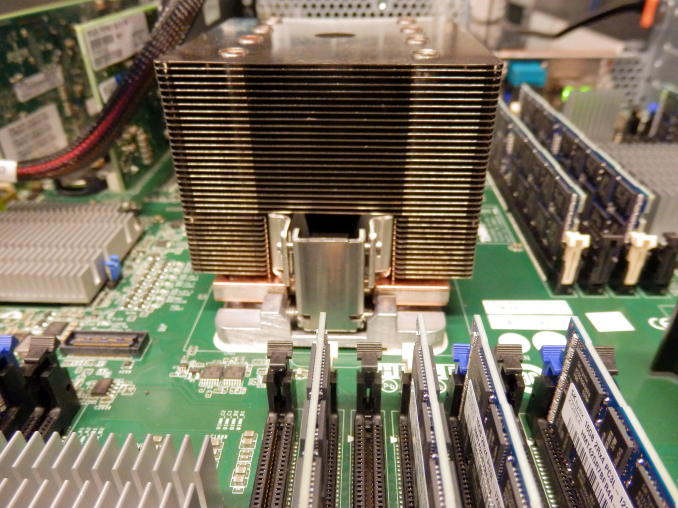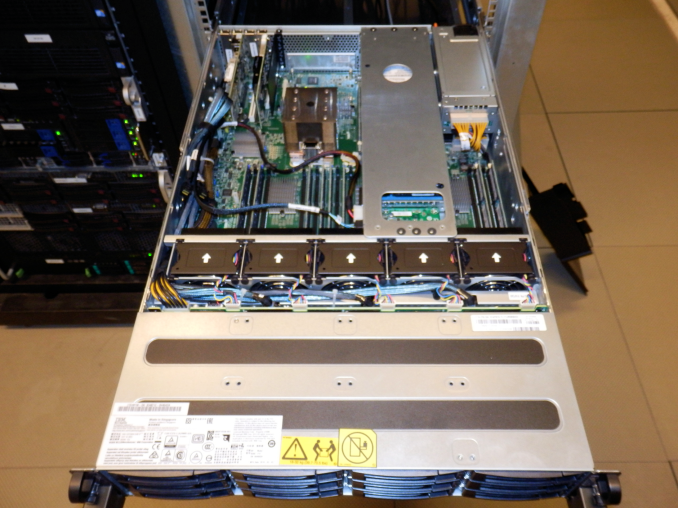Assessing IBM's POWER8, Part 1: A Low Level Look at Little Endian
by Johan De Gelas on July 21, 2016 8:45 AM EST
It is the widest superscalar processor on the market, one that can issue up to 10 instructions and sustain 8 per clock: IBM's POWER8. IBM's POWER CPUs have always captured the imagination of the hardware enthusiast; it is the Tyrannosaurus Rex, the M1 Abrams of the processor world. Still, despite a flood of benchmarks and reports, it is very hard to pinpoint how it compares to the best Intel CPUs in performance wise. We admit that our own first attempt did not fully demystify the POWER8 either, due to the fact that some immature LE Linux software components (OpenJDK, MySQL...) did not allow us to run our enterprise workloads.
Hence we're undertaking another attempt to understand what the strengths and weaknesses are of Intel's most potent challenger. And we have good reasons besides curiosity and geekiness: IBM has just recently launched the IBM S812LC, the most affordable IBM POWER based server ever. IBM advertises the S812LC with "Starting at $4,820". That is pretty amazing if you consider that this is not some basic 1U server, but a high expandable 2U server with 32 (!) DIMM slots, 14 disk bays, 4 PCIe Gen 3 slots, and 2 redundant power supplies.
Previous "scale out" models SL812 and SL822 were competitively priced too ... until you start populating the memory slots! The required CDIMMs cost no less than 4(!) times more than RDIMMs, which makes those servers very unattractive for the price conscious buyers that need lots of memory. The S812LC does not have that problem: it makes use of cheap DDR3 RDIMMs. And when you consider that the actual street prices are about 20-25% lower, you know that IBM is in Dell territory. There is more: servers from Inventec, Inspur, and Supermicro are being developed, so even more affordable POWER8 servers are on the way. A POWER8 server is thus quite affordable now, and it looks like the trend is set.
To that end, we decided that we want to more accurately measure how the POWER8 architecture compares to the latest Xeons. In this first article we are focusing on characterizing the microarchitecture and the "raw" integer performance. Although the POWER8 architecture has been around for 2 years now, we could not find any independent Little Endian benchmark data that allowed us to compare POWER8 processors with Intel's Xeon processors in a broad range of applications.
Notice our emphasis on "Little Endian". In our first review, we indeed tested on a relatively immature LE Ubuntu 14.04 for OpenPOWER. Some people felt that this was not fair as the POWER8 would do a lot better on top of a Big Endian operating system simply because of the software maturity. But the market says otherwise: if IBM does not want to be content with fighting Oracle in an ever shrinking high-end RISC market, they need to convince the hyper scalers and the thousands of smaller hosting companies. POWER8 Server will need to find a place inside their x86 dominated datacenters. A rich LE Linux software ecosystem is the key to open the door to those datacenters.
When it comes to taking another crack at our testing, we found out that running Ubuntu 15.10 (16.04 was just out yet when we started testing) solved a lot of the issues (OpenJDK, MySQL) that made our previous attempt at testing the POWER8 so hard and incomplete. Therefore we felt that despite 2 years of benchmarking on POWER8, an independent LE Linux-focused article could still add value.











124 Comments
View All Comments
abufrejoval - Thursday, August 4, 2016 - link
I believe "heavily threaded" is somewhat imprecise here: Knights Landing (KNL) is really more about vectorized workloads, or one very loopy and computationally expensive problem, which has been partitioned into lots of chunks, but has high locality. Same code, related data, far more computational throughput than data flowthrough.Power8 will do better on such workloads than perhaps Intel, but never as good as a GPU or KNL.
However it does evidently better per core on highly threaded workloads, where lots of execution threads share the same code but distinct or less related datasets, less scientific and more commercial workloads, more data flowing through.
Funnily KNL might even do well there, beating its Xeon-D sibling in every benchmark, even in terms of energy efficience.
But I'm afraid that's because most of the KNL surface area would remain dark on such workload while the invests would burn through any budget.
KNL is an odd beast designed for a rather specific job and only earn its money there, even if you can run Minecraft or Office on it.
Kevin G - Friday, July 22, 2016 - link
I do think comparison with Xeon Phi is fair since it can run/boot itself now with Knight's Landing. Software parity with the normal x86 ecosystem is now there so it can run off the shelf binaries.I am very curious how well such a dense number of cores perform for workloads that don't need high single threaded performance.
Another interest factor would be memory bandwidth performance as Xeon Phi has plenty. The HMC only further enhances that metric and worth exploring it as both a cache and main memory region for benchmarks.
Ratman6161 - Thursday, July 21, 2016 - link
Will you be addressing virtualization in a future article. I ask this because you are saying the lower cost Power8 systems are intended to compete with the Dell's, HP's, Lenovo etc x86 servers. But these days, a very high percentage of x86 work loads are virutalized either on VMWare or competing products. In 2009 Gartner had it at about 50% and by 2014 it was at 70%. I didn't find a number for '15 or '16 but I expect the percentage would have continued to rise. So if they want to take the place of x86 boxes, they have to be able to do the tasks those boxes do...which tends to largely be to run virtual machines that do the actual workloads.And, what about all the x86 boxes running Windows Server or more commonly Windows Server Virtual machines? Windows Server shops aren't likely to ditch windows in favor of Linux solely for the privilege of running on Power8?
One last thing to consider regarding price. These days we can buy quite robust Intel based server for around $10K. So, supposing I can buy a Power8 system for about the same price? Essentially the hardware has gotten so cheap compared to the licensing and support costs for the software we are running that its a drop in the bucket. If we needed 10 Intel servers or 6 Power 8's to do the same job (assuming the Power8's could run all our VM's), the Power8's could come out lower priced hardware wise, but the difference is, as I said, a drop in the bucket in the overall scheme of things. Performance wise, with the x86 boxes, you just throw more cores at it.
aryonoco - Friday, July 22, 2016 - link
KVM works well on POWER.No idea about proprietary things like VMWare. But that would be up to them to port.
Ratman6161 - Friday, July 22, 2016 - link
Near as I can tell, there is a PowerKVM that runs on Power 8 but that doesn't allow you to run Windows Server VM's - seems to support only Linux guests.Zetbo - Saturday, July 23, 2016 - link
Windows does not support POWER, so there is no point of using POWER if you need Windows!utroz - Thursday, July 21, 2016 - link
AMD should have used IBM's 22nm SOI to make cpu's so that they would not have been totally dead in the performance and server cpu market for years. GF now owns this process as they "bought" IBM's fabs and tech. I think that 22nm SOI might be better for high speed cpu's than the 14nm LPP FinFet that AMD is using for ZEN at the cost of die size.amagriva - Thursday, July 21, 2016 - link
How much you payed your cristal ball?spikebike - Thursday, July 21, 2016 - link
So a single socket Power8 is somewhat faster than the intel chip. But is being compared in a single socket configuration where the intel is designed for a two socket. Unless the power8 is cheaper than an intel dual socket seems most fare to compare both CPU as they are designed to be used.SarahKerrigan - Friday, July 22, 2016 - link
Power is designed for systems up to 16 sockets (IBM E880.) One socket is just the entry point.